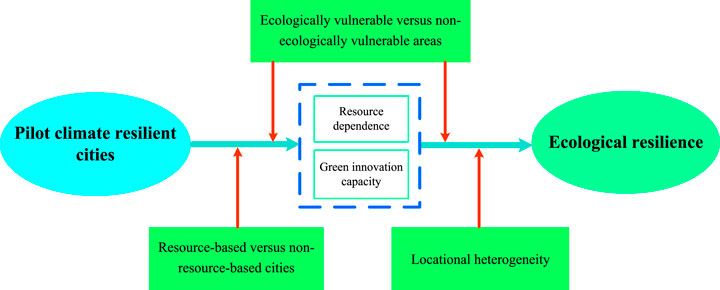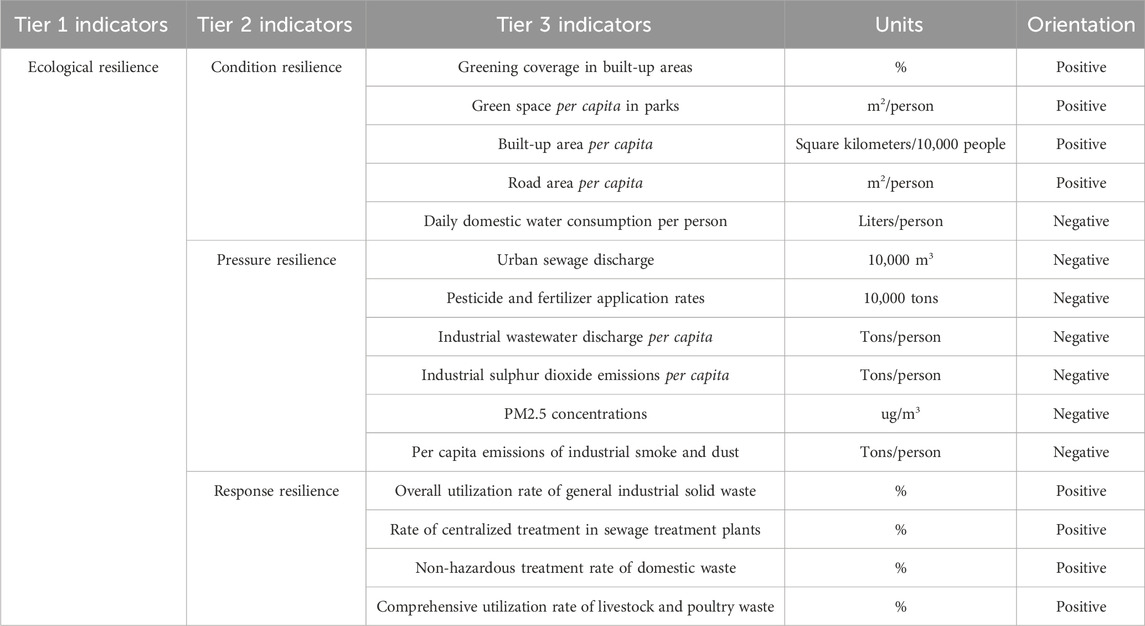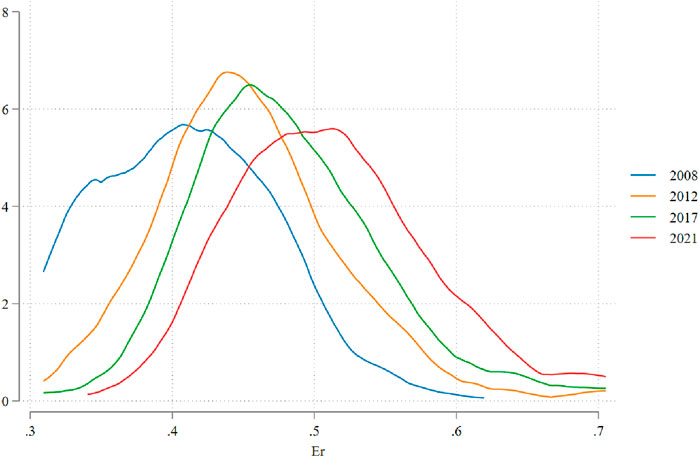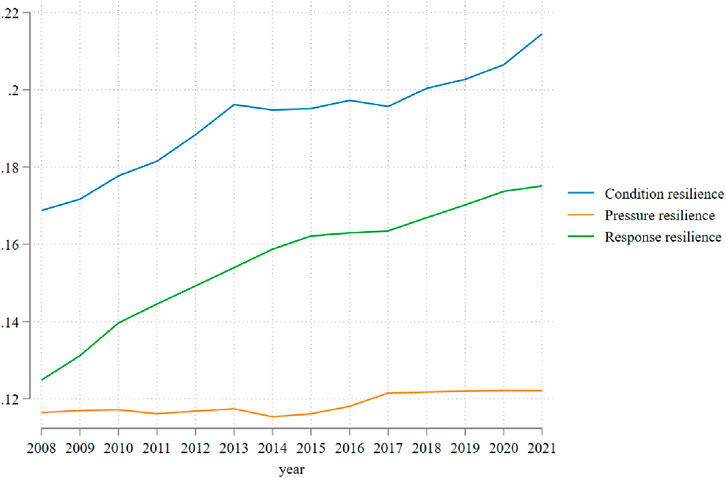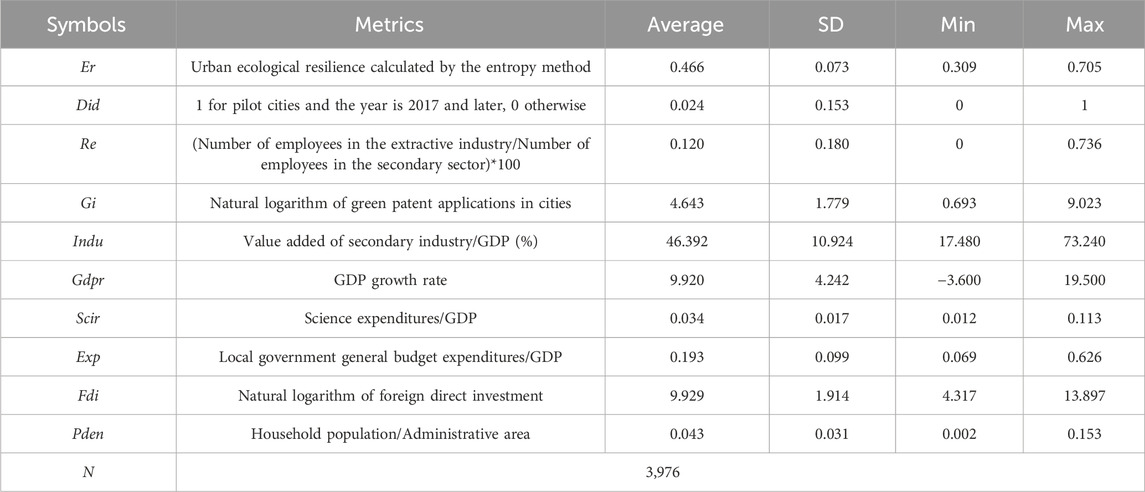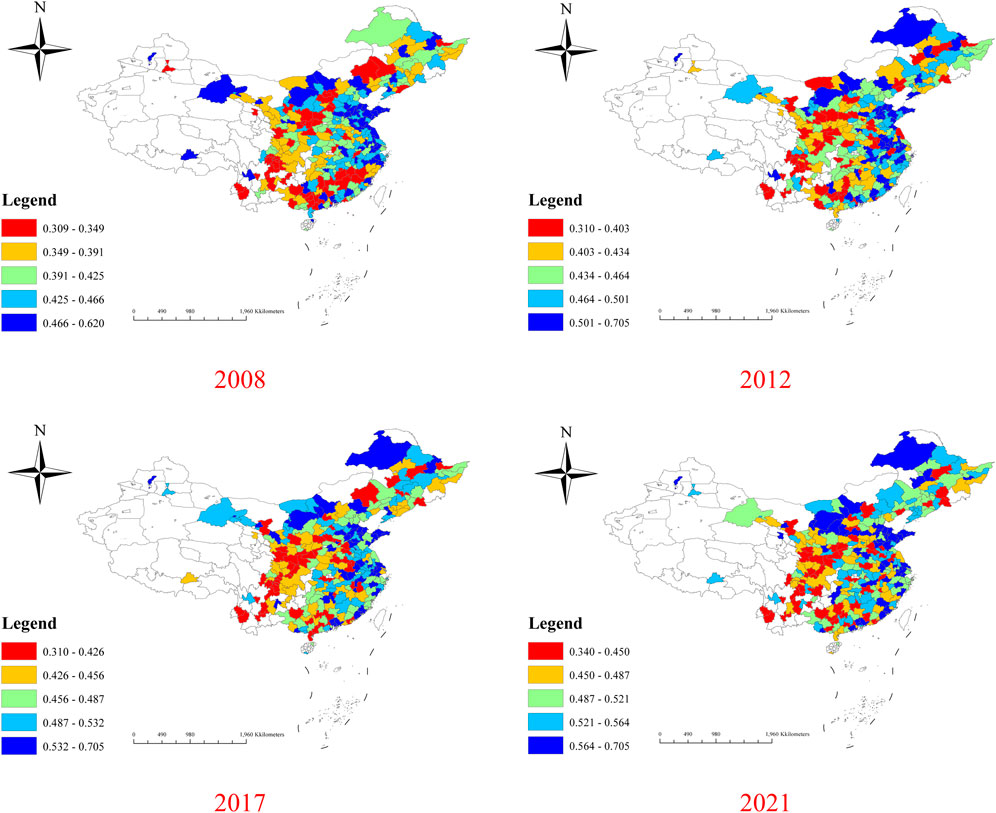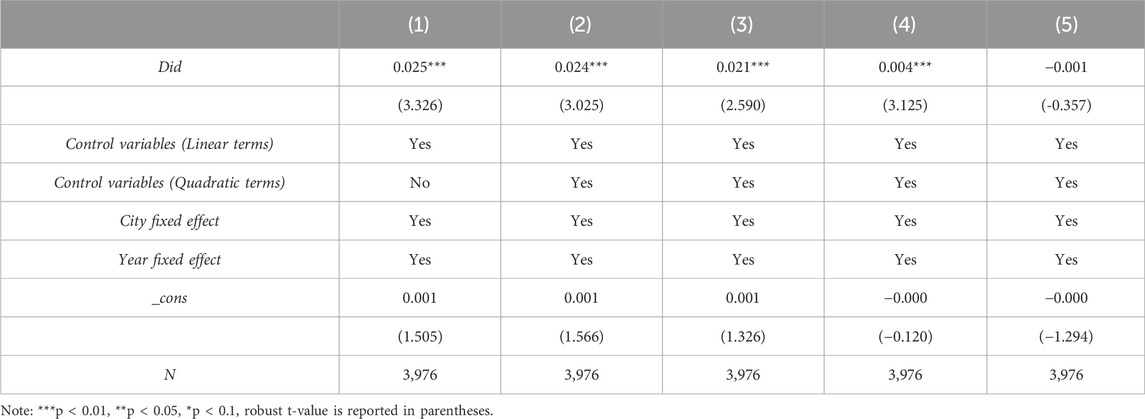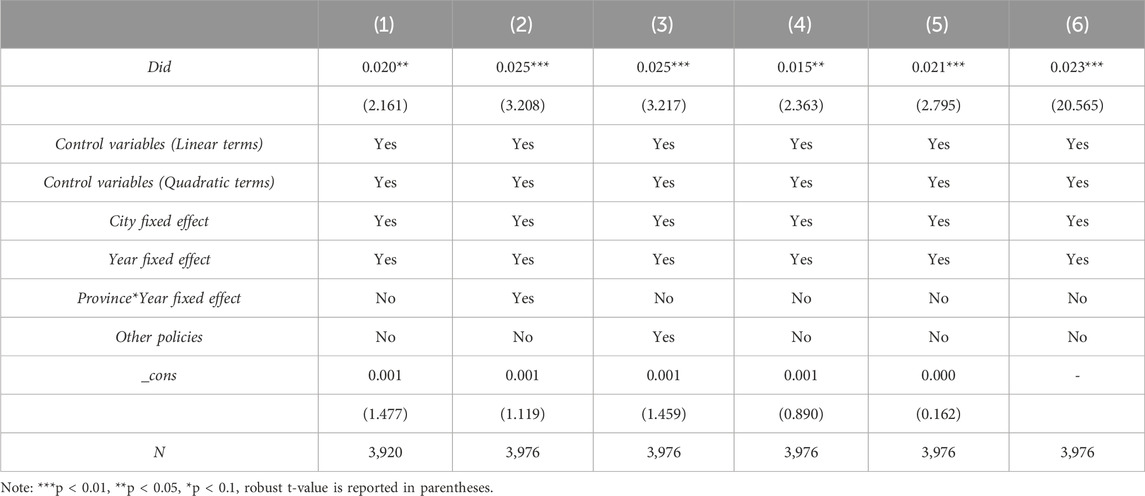- 1Economics and Management College, China University of Geosciences, Wuhan, China
- 2Economics and Environment Research Center, China University of Geosciences, Wuhan, China
As climate change poses an escalating threat to the global ecological environment, strengthening urban ecological resilience has become a pressing priority. Our research leverages China’s “Pilot Climate Resilient Cities” (PCRC) initiative as a quasi-natural experiment, employing the Double Machine Learning approach to assess its impact on ecological resilience. The findings reveal that the PCRC significantly enhances pilot cities’ ecological resilience. Mechanism analysis indicates that reducing resource dependence and fostering green innovation are the two primary channels through which the PCRC improves ecological resilience. Heterogeneity analysis indicates that the PCRC’s effects are particularly pronounced in resource-based cities, as well as in ecologically fragile regions and central and western areas of China. This study not only provides empirical support for the formulation and optimization of climate adaptation policies, but also offers crucial theoretical insights for designing differentiated policies across various types of cities.
1 Introduction
Climate change has emerged as a significant challenge in global environmental governance, and the frequency of extreme weather events and increased pressure on ecosystems seriously threaten the sustainable development of cities (IPCC, 2023; Yuan et al., 2024). The “2023 State of the Global Climate” report highlights that the earth has set new records in average temperature, glacier melt, sea level rise, and ocean heat content.1 As one of the world’s most prominent monsoon climate regions, China is particularly susceptible to frequent meteorological disasters and complex climate risks (Cai et al., 2025; Tang et al., 2024), positioning it as highly sensitive to climate change (Hong et al., 2019; Jiang and Jiang, 2024; Zhou et al., 2023). China’s climate challenges extend beyond domestic ecological and social concerns, significantly influencing global climate governance (Huang et al., 2023). China bears a substantial responsibility in international climate negotiations, and its climate governance actions are critical to the global effort to mitigate climate change (Liao, 2024; Qi and Dauvergne, 2022; Xu and Zhang, 2022). Climate change is no longer merely an environmental issue, it is a strategic concern with implications for national security, social stability, and economic development (Chen and Gong, 2021; Lee et al., 2024; Sun et al., 2024). Consequently, examining China’s climate change challenges, particularly the effectiveness of its climate governance measures, holds significant theoretical and practical importance.
The United Nations’ 2030 Agenda for Sustainable Development designates “building inclusive, safe, resilient, and sustainable cities and human settlements” as one of its key goals,2 underscoring the global emphasis on urban resilience to climate change. As climate change intensifies, cities increasingly face a range of novel and compound disasters, such as smog, heatwaves, and urban flooding, which frequently threaten critical urban lifeline systems including water, electricity, gas, and transportation (Chen et al., 2023; Yan, 2024; Zheng et al., 2021). Consequently, the development of resilient cities capable of effectively responding to climate change has emerged as a priority for governments worldwide (Amirzadeh et al., 2023; Banai, 2020; Zahoor et al., 2023). Ecological resilience, defined as a city’s capacity to adapt, withstand, and recover from climate change and other ecological stresses, has garnered significant attention among researchers and policymakers (Li and Wang, 2023; Wang et al., 2023a; Wang et al., 2022). Strengthening ecological resilience not only strengthens a city’s capacity to withstand extreme weather events, but also promotes sustainable development (Shamsipour et al., 2024; Wu et al., 2024; Zhang et al., 2023). In this context, ecological resilience has become a crucial component of climate change adaptation strategies (Wang et al., 2024b; Zhang et al., 2024; Zhou et al., 2024).
Since 2012, the government has introduced various climate governance policies, culminating in the launch of the “Pilot Climate Resilient Cities” (PCRC) initiative in 2017. The PCRC incorporates climate factors into urban planning and development, aiming to enhance climate governance in cities. Within this framework, pilot cities have progressively adopted a range of measures, such as strengthening disaster-resistant infrastructure and improving urban environmental management, to address the challenges posed by climate change. However, the effectiveness of the PCRC remains to be thoroughly evaluated. To this end, we employ the Double Machine Learning (DML) approach to empirically assess the PCRC’s impact on urban ecological resilience. Through heterogeneity and mechanism analyses, we systematically quantify the policy’s effectiveness from multiple perspectives. The findings not only provide critical theoretical support for advancing climate resilient cities in China, but also offer valuable insights for other developing countries and regions striving to combat climate change and enhance ecological resilience.
The potential innovations are threefold. First, while research on urban resilience has expanded in recent years, much of the focus has been on social and economic resilience (Champlin et al., 2023; Feng et al., 2023; Hu et al., 2022), with relatively limited exploration of ecological resilience. Our research advances the understanding of ecological resilience by constructing a comprehensive indicator system that encompasses the dimensions of status, pressure, and response. Second, unlike traditional causal inference methods such as Difference-in-Differences (DID) and Regression Discontinuity Design, this paper employs the DML method to more precisely estimate the effect of the PCRC on ecological resilience. Our DML approach offers significant advantages in handling high-dimensional data and complex nonlinear relationships, thereby mitigating biases arising from model misspecification. By enhancing the accuracy of causal inference, the DML provides a more robust tool for policy evaluation and opens new avenues for research in urban ecological resilience (Bodory et al., 2022; Knaus, 2022; Ling et al., 2024). Third, our findings suggest that the PCRC can enhance ecological resilience by reducing resource dependence, thereby expanding the channels through which the governments can improve ecological resilience. Consequently, this paper not only enriches the theoretical framework surrounding ecological resilience, but also offers a novel academic perspective for exploring diverse pathways to strengthen ecological resilience.
2 Institutional background and research hypotheses
2.1 Pilot climate resilient cities in China
The intensification of global climate change has exacerbated ecological and environmental challenges in urban areas (Tang et al., 2023; Zor, 2023). In China, a densely populated nation with highly concentrated economic activities, the impact of climate change on cities is particularly pronounced. Urban areas not only host large populations and economic activities, but are also vulnerable to disruptions in infrastructure, energy supply, and transportation networks caused by climate-related events. To address these challenges, the National Development and Reform Commission of China issued the PCRC in 2017,3 which aims to enhance cities' capacity to adapt to climate change and ensure sustainable development. The PCRC designated 28 regions, including Hohhot in Inner Mongolia and Dalian in Liaoning Province, as pilot cities for climate adaptation. The distribution of the pilot cities is exhibited in Figure 1, which includes both provincial capitals and non-capital cities across eastern, central, and western China (Note: Fewer than 28 pilot regions are represented in Figure 1, as some of the pilot areas are counties, which fall outside the scope of this study). The PCRC represents not only a direct response to the growing significant impacts of climate change, but also a strategic initiative by the Chinese government to meet its climate commitments within the framework of international climate governance and advance its ecological civilization agenda (Huang and Yi, 2024; Wang and Chen, 2024).
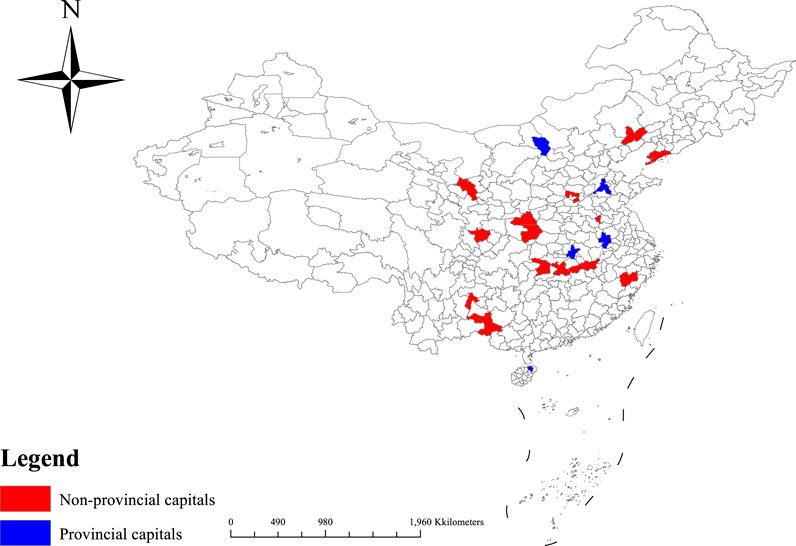
Figure 1. The distribution of pilot cities. Note: The base map is from the Department of Natural Resources’ Standard Map Service System, review number GS (2024) 0650, and the base map is unaltered. The same below.
Given the profound impact of climate change on urban development in China, there is a pressing need for strategic, top-down planning at the national level. The PCRC outlines a series of targeted actions aimed at enhancing cities’ ability to cope with climate change. These include strengthening climate monitoring and early warning systems, as well as improving meteorological disaster prediction and response mechanisms. In particular, the PCRC focuses on optimizing the layout of urban infrastructure to better respond to extreme weather events, such as heavy rainfall, heatwaves, and droughts. Additionally, the PCRC emphasizes the restoration and protection of urban ecosystems by increasing the presence of natural elements such as green spaces, forests, and lakes. This approach aims to enhance urban functions related to water conservation, temperature regulation, and soil retention, while mitigating urban heat island effects and flooding risks. Moreover, the PCRC encourages pilot cities to serve as policy experimentation hubs by promoting institutional innovation and public-private partnership models to attract private investment in climate adaptation projects. Such initiatives not only provide policy support and financial backing for pilot cities, but also offer valuable lessons and models for other cities to follow.
2.2 Research hypotheses
The PCRC provides a forward-looking framework for sustainable urban development through systematic policy planning and scientific implementation. First, the PCRC strengthens cities’ capacity to adapt to climate change by guiding policy formulation, allocating resources, and fostering technological innovation. Pilot cities are prioritized for the adoption of proactive adaptation measures, such as enhancing urban infrastructure, improving environmental monitoring systems, and promoting green building practices (Feng et al., 2024; Haarstad et al., 2024). These initiatives not only bolster cities’ resilience to extreme weather events, but also improve the overall urban ecological environment, thereby advancing urban ecological resilience (Liu et al., 2022; Wang and Chen, 2024). Second, the PCRC promotes a multi-level governance structure and cross-sectoral collaboration. Urban climate adaptation depends not only on technological and engineering solutions, but also on integrated governance and multi-stakeholder participation (Iturriza et al., 2020; Liao and Zhang, 2024). Pilot projects often involve extensive collaboration among government agencies, businesses, non-governmental organizations, and local communities. This multi-stakeholder model facilitates the integration of systematic adaptation strategies into urban planning, construction, and management, optimizing resource allocation and improving governance effectiveness (Huang and Yi, 2024). Furthermore, this collaborative mechanism strengthens societal capacity to address climate change challenges, contributing to the enhancement of ecological resilience.
Hypothesis 1. The PCRC can significantly improve urban ecological resilience.
Traditional urban development models have heavily relied on external resources, including energy, water, and construction materials, rendering cities highly susceptible to supply chain disruptions. The PCRC seeks to address this vulnerability by promoting the development of green infrastructure, energy-efficient buildings, and the widespread adoption of renewable energy sources. For example, pilot cities are encouraged to enhance localized energy production, such as solar and wind energy, thereby decreasing dependence on external energy supplies (Shi and Fan, 2024; Zheng et al., 2023). These strategies not only mitigate cities’ dependence on external resources, but also bolster urban capacity to respond to resource shortages or sudden climate events, ultimately strengthening ecological resilience (Cui et al., 2024). Furthermore, the PCRC emphasizes the importance of localized resource recycling and waste management (Liu et al., 2023). By fostering more autonomous and sustainable resource management systems, pilot cities can minimize carbon emissions associated with resource transportation and enhance their adaptive capacity in the face of resource shortages (Jiang et al., 2024; Zhao et al., 2022). Thus, by decreasing reliance on external resources, the PCRC enhances cities’ ability to cope with climate change and increases overall ecological resilience. Therefore, we propose Hypothesis 2:
Hypothesis 2. The PCRC can increase urban ecological resilience by reducing resource dependence.
The PCRC actively cultivates an environment conducive to green innovation by optimizing infrastructure, enhancing technical support, and improving legal and market frameworks. For example, pilot cities may prioritize the development of smart grids, green buildings, and clean energy infrastructure, providing the necessary physical support for the application and dissemination of green technologies. Additionally, the pilot policies promote the establishment of intellectual property protection mechanisms and green technology standards, ensuring that innovations are adequately protected and can be widely adopted (Wen et al., 2024). These measures foster a robust ecosystem favorable to green innovation, enabling innovators to conduct research and development in a more stable and supportive environment. Simultaneously, the PCRC stimulates market demand for green products and technologies through policy incentives and demonstration projects. This growing demand not only drives the further development and application of green technologies, but also significantly enhances the competitiveness of firms in the green innovation sector (Huang and Yi, 2024). As demand for low-energy buildings, water-saving technologies, and ecological restoration solutions continues to rise, businesses and research institutions are increasing their investments in these areas, thereby accelerating the pace of green innovation. By leveraging the catalytic effect of market demand, pilot cities have significantly strengthened their capacity for green innovation, providing a solid technological foundation for enhancing urban ecological resilience. So, we propose:
Hypothesis 3. The PCRC can improve urban ecological resilience by increasing green innovation capacity.
2.3 Theoretical framework
As shown in Figure 2. The PCRC enhances urban ecological resilience by addressing both the systemic vulnerabilities of cities and their adaptive capacities in the face of climate change. The PCRC enables the implementation of proactive measures, including the optimization of urban infrastructure, establishment of robust environmental monitoring systems, and promotion of green building practices. These interventions reduce cities’ exposure and sensitivity to climate-related risks, such as extreme weather events, while simultaneously enhancing their capacity to absorb, recover, and adapt. Moreover, the PCRC fosters a multi-stakeholder governance framework that integrates public institutions, private enterprises, and local communities, ensuring the efficient allocation of resources and the adoption of holistic adaptation strategies (Jiao et al., 2023). This collaborative approach strengthens the overall resilience of urban systems by embedding climate adaptation measures into urban planning, management, and daily operations, thereby safeguarding ecological functionality and long-term sustainability (Wang and Chen, 2024).
The PCRC plays a crucial role in enhancing ecological resilience by reducing resource dependence and promoting green innovation. By focusing on sustainable resource management, the PCRC helps cities shift away from over-reliance on finite or environmentally harmful resources. Such a transition is particularly important in the context of climate change, as it alleviates pressure on ecosystems and strengthens their ability to recover from shocks. Policies that promote renewable energy, sustainable land use, and efficient waste management reduce the dependency on non-renewable resources and reduce environmental degradation. Furthermore, the PCRC fosters green innovation, which includes the development and application of environmentally friendly technologies. This can involve advances in energy efficiency, water conservation, and sustainable urban infrastructure. Green innovation enables cities to enhance their resilience by facilitating adaptive measures to cope with climate impacts. In this way, the PCRC improves ecological resilience not only through resource efficiency, but also by creating a conducive environment for sustainable technological and organizational innovation that supports long-term environmental sustainability.
The impact of climate-adaptive urban pilot policies on ecological resilience is heterogeneous, influenced by several key factors such as resource base classification, ecological vulnerability, and locational heterogeneity. First, the classification according to resource base distinguishes between regions with abundant versus scarce natural resources, which in turn affects the extent to which these policies can be effective. In resource-based cities, the urgency to minimize resource consumption may drive more immediate adoption of efficient practices and green technologies. Second, ecological fragility plays a critical role in determining the impact of the PCRC. Ecologically fragile areas, which are more susceptible to environmental degradation, benefit more significantly from climate adaptation measures, as these areas often face higher vulnerability to climate-related risks. In contrast, non-ecologically fragile areas may experience less immediate need for such measures. Lastly, locational heterogeneity, including geographical and socio-economic differences, influences how these policies are implemented and their outcomes. Urban areas in diverse locations, whether due to climate variability or socio-economic conditions, will experience differing effects based on their local adaptation capacities, institutional frameworks, and public engagement.
3 Research design
3.1 Data source
In 2007, China’s State Council issued the National Program for Addressing Climate Change,4 marking a turning point in the government’s increased focus on climate governance. Given that city-level data for some variables is only available up to 2021, we have selected the study period from 2008 to 2021. After excluding cities with severe data deficiencies, we construct a balanced panel dataset covering 284 cities. Data on urban green patent applications are obtained from the CNRDS database, while other variables are sourced from the China City Statistical Yearbook, the EPS database. All continuous variables are winsorized at the 1% level.
3.2 Variable metrics
3.2.1 Dependent variable
Ecological resilience (Er). Ecological resilience is the ability of an ecosystem to preserve the stability of its structure and function when confronted with external disturbances or environmental changes, and to either recover swiftly or transition into a more organized state after disruption (Jiang and Jiang, 2024; Wang and Ge, 2024; Wang et al., 2023c3). To more precisely measure ecological resilience, this study decomposes it into three dimensions: condition resilience, pressure resilience and response resilience (Gao et al., 2024). Condition resilience primarily assesses the stability and health of the ecosystem under normal conditions, including biodiversity, ecological balance, and environmental quality. Pressure resilience focuses on the extent to which the ecosystem can maintain its essential functions and services when confronted with external pressures such as pollution, resource depletion, or climate change. Response resilience examines the system’s ability to adapt and recover from shocks, including its capacity to realign its structure, adapt to environmental changes, and prevent further degradation. By evaluating these three dimensions, ecological resilience provides policymakers with a comprehensive assessment of ecosystem health, facilitating more effective environmental management and risk mitigation strategies (Ning et al., 2024). As shown in Table 1, the evaluation framework for ecological resilience in this study comprises three secondary indicators and 15 tertiary indicators. Following Zhou et al. (2021), the entropy approach is employed to calculate ecological resilience.
Figure 3 presents the kernel density estimates of ecological resilience for the years 2008, 2012, 2017, and 2021, with different colored curves representing each respective year. The distribution of ecological resilience across these years exhibits a unimodal pattern. Over time, the peak of ecological resilience initially increases and then decreases. Additionally, the peak moves progressively to the right, suggesting an overall improvement in ecological resilience across cities during this period.
Figure 4 provides a comprehensive depiction of the temporal trends in ecological resilience across its three dimensions-condition resilience, response resilience, and pressure resilience-during the period from 2008 to 2021. The visual representation reveals notable differences in the growth trajectories and magnitudes of these dimensions, offering insights into the evolving dynamics of ecosystem resilience over time.
Condition resilience demonstrates a clear and sustained upward trajectory throughout the analyzed period, reflecting significant improvements in the stability and health of ecosystems under normal environmental conditions. The steady increase in condition resilience may be attributed to concerted efforts in biodiversity conservation, ecosystem restoration, and policy initiatives aimed at improving ecological health and mitigating environmental degradation. Response resilience also exhibits an upward trend, this suggests that ecosystems have gradually enhanced their capacity to recover and adapt to environmental disturbances or shocks. The improvement in response resilience highlights the growing emphasis on adaptive management practices and resilience-building strategies, such as ecological restoration projects, disaster risk reduction measures, and adaptive governance frameworks. In contrast, pressure resilience presents a markedly different trend. While this dimension shows some minor fluctuations, its overall level remains relatively stable over the study period and significantly lower than the levels observed for condition and response resilience. Pressure resilience, which reflects the ecosystem’s ability to maintain essential functions and services under external stressors such as pollution, resource depletion, and climate change, appears to have faced persistent limitations. This stability could suggest that the measures aimed at mitigating external pressures have had a limited impact on substantially enhancing ecosystems’ tolerance to ongoing stressors. It may also reflect structural constraints, such as slow progress in reducing pollution levels or transitioning to sustainable resource-use patterns in certain regions.
Figure 4 highlights the multifaceted and uneven nature of ecological resilience improvements across its three dimensions. While substantial progress has been made in enhancing condition resilience and, to a lesser extent, response resilience, the limited changes in pressure resilience underscore the need for targeted interventions. Policymakers and practitioners should prioritize addressing the persistent challenges associated with pressure resilience while sustaining the gains in condition and response resilience. Such efforts are essential for achieving a comprehensive and balanced enhancement of ecological resilience that ensures the stability, functionality, and adaptability of ecosystems in the face of environmental change.
3.2.2 Independent variable
Pilot climate resilient cities (Did). We employ the PCRC as a quasi-natural experiment. Did is set to 1 for cities designated as pilot cities in 2017 or later, and 0 otherwise. The PCRC, aimed at mitigating climate risks, holds significant potential for enhancing urban ecological resilience and risk management capacity.
3.2.3 Mechanism variables
Resource dependence (Re). Following Dong et al. (2022), we measure resource dependence using the percentage of employment in the extractive industries to employment in the secondary sector. The extractive industries include resource-intensive sectors such as mining, oil, and natural gas, which are directly reliant on natural resource extraction. A higher ratio typically indicates that a region’s economic development is heavily dependent on the exploitation and utilization of natural resources, thereby reflecting the degree of resource dependence.
Green innovation (Gi). Following Filiou et al. (2023), we employ green patent applications to measure a city’s green innovation capacity. Green patents typically encompass environmentally friendly technologies, energy-saving innovations, and renewable energy technologies. The volume of green patent applications serves as a direct indicator of a city’s innovation activity and capacity in green technologies. A higher number of applications suggests greater investment and stronger innovation capabilities in green technology development. This metric reflects the city’s potential for sustainable development and ecological transition, offering valuable insights for the formulation and evaluation of urban sustainability policies.
3.2.4 Control variables
Our study controls for several additional socioeconomic variables that may influence ecological resilience, following Wang et al. (2023b) and Hu et al. (2024). The control variables include: industrial structure (Indu), measured as the percentage of secondary industry value added to GDP; economic development level (Gdpr), proxied by the city's GDP growth rate; scientific expenditure (Scir), defined as the percentage of a city’s scientific expenditure to GDP; government intervention (Exp), calculated as the percentage of municipal fiscal expenditures to GDP; foreign direct investment (Fdi), expressed as the natural logarithm of the actual amount of foreign capital utilized in the given year; population density (Pden), measured as the number of registered residents divided by the city’s administrative area.
3.3 Research methodology
The application of the DML method offers significant advantages in evaluating the effect of the PCRC on ecological resilience. First, ecological resilience is influenced by a multitude of complex, interrelated economic, social, and environmental factors, which often exhibit highly nonlinear relationships (Hansen and Siggaard, 2024; Liu et al., 2024). Traditional causal inference models, such as the DID approach, while widely used in policy evaluation, face several challenges when dealing with high-dimensional data. For instance, the DID model requires the parallel trends assumption, which is difficult to satisfy in practice, especially when evaluating complex environmental policies. In contrast, the DML employs regularization algorithms to automatically select relevant control variables from high-dimensional data, effectively mitigating the “curse of dimensionality” and enhancing estimation precision and reliability (Gao et al., 2024; Wang et al., 2024a). This method not only overcomes the limitations of traditional models in handling complex datasets, but also accurately captures the true effects of policy interventions without relying on strict linear assumptions.
The DML approach also excels in addressing nonlinear relationships, which is crucial when evaluating the effect of the PCRC on ecological resilience. The relationship between ecological resilience and policy interventions is likely nonlinear, a complexity that traditional linear regression models may struggle to capture, potentially leading to unreliable estimates. The DML is capable of more accurately estimating causal effects in the presence of high-dimensional data and nonlinear relationships (Liu et al., 2021). Specifically, the DML utilizes cross-fitting and orthogonalization techniques, which reduce regularization bias and overfitting issues commonly encountered in machine learning methods, thereby enhancing the robustness and accuracy of estimates (Zhao et al., 2024). The DML not only better handles the complexities of data processing, but also provides policymakers with a more scientific and reliable foundation for decision-making.
In view of this, referring to Chernozhukov et al. (2017), we design a partially linear DML model to evaluate the effect of the PCRC:
among them, i represents cities, t represents years; Yit+1 is the dependent variable; Didit is the treatment variable, indicating whether city i is selected for the PCRC in year t (with a value of 1 if selected, and 0 otherwise);
In Equation 3, where n is the sample size.
The estimation bias is then checked.
In Equation 4,
Auxiliary regressions are as follows:
In Equation 5,
In Equation 7, first, the auxiliary regression
4 Analysis of the results
4.1 Descriptive statistics
As showed in Table 2. The mean of ecological resilience (Er) is 0.466, with a minimum of 0.309 and a maximum of 0.705, indicating substantial variation in ecological resilience levels across cities. The average resource dependence (Re) is 0.120, suggesting that, on average, the ratio of employees in the extractive industry relative to the secondary industry workforce is approximately 0.12%. Additionally, the wide range between the minimum and maximum values of green patent applications (Gi) highlights significant disparities in green innovation capacity across cities.
4.2 The spatial and temporal patterns of ecological resilience
We create spatial distribution maps of ecological resilience, to provide a visual representation of its spatiotemporal variation. Figure 5 presents the results for the years 2008, 2012, 2017, and 2021. The maps reveal that areas with higher ecological resilience are primarily concentrated in eastern China, particularly in regions such as the Shandong Peninsula, Jiangsu Province, and Zhejiang Province. These areas exhibit higher resilience levels due to their strong economic foundations and robust environmental governance capacities. In contrast, regions with lower ecological resilience are predominantly located in northwestern and southwestern China, where limited economic development and challenging natural conditions constrain resilience levels. Notably, in 2008, both Guangxi and Guangdong provinces had relatively low levels of ecological resilience. However, by 2021, their ecological resilience had improved significantly.
4.3 Baseline results
The DML model is employed in this study. Specifically, we utilize a random forest algorithm for prediction, with a sample split ratio of 1:4. As exhibited in Table 3. Column (1) controls for the linear terms of other urban control variables. The result indicates that the pilot program’s coefficient on urban ecological resilience is positive (Huang and Yi, 2024; Wang and Chen, 2024). Building on this, column (2) further includes the quadratic terms of urban control variables. The coefficient remains significantly positive, with little difference from the results of column (1). Thus, Hypothesis 1 is confirmed. The paper also explores the impact of the PCRC on the ecological resilience sub-dimension. The dependent variables in columns (3)–(5) are condition resilience, pressure resilience and response resilience, respectively. The results show that the PCRC significantly improves condition resilience and pressure resilience, especially condition resilience, in the pilot cities, while the effect on response resilience is insignificant.
4.4 Robustness checks
The baseline regression results confirm the effectiveness of the PCRC. To further validate this conclusion, we conducted a series of robustness checks. First, we consider the unique administrative status of the four directly governed municipalities, namely, Beijing, Tianjin, Shanghai, and Chongqing, by excluding these cities from the analysis and re-estimating the model. The result is presented in column (1) of Table 4, remain consistent with our initial findings. Secondly, as exhibited in column (4), following Chen et al. (2018), we incorporate the interaction fixed effects of province and year to account for regional temporal features. Third, during the period 2008–2021, the government implemented a range of environmental regulatory measures, and these environmental governance tools are likely to affect ecological resilience. In view of this, we include policies such as pilot low-carbon cities, pilot carbon emissions trading, air pollution prevention and control action plans, pilot zones for green financial reform and innovation, and pilot smart cities as control variables in the model. The result is presented in column (3).
Given the potential subjectivity in model specification, we next perform robustness checks by adjusting the model design. We change the initial sample split ratio from 1:4 to 1:2, with the results shown in column (4). This adjustment has minimal impact on the baseline conclusions. In column (5), we then replace the random forest algorithm with a gradient boosting algorithm. Lastly, while the baseline regression employs a partially linear model based on the DML, we substitute this with a more general interactive model to examine the sensitivity of our findings to model specification. The results, presented in column (6), remain consistent with the baseline conclusions.
4.5 Mechanism analysis
Compared to the traditional three-step approach, the two-step method offers greater advantages in addressing endogeneity issues (Baron, 2022). Therefore, this section employs the two-step method to examine the mechanisms through which the PCRC enhances urban ecological resilience.5
4.5.1 Reducing resource dependence
Following Dong et al. (2022), we measure resource dependence using the ratio of employment in the mining sector to employment in the secondary sector. We treat resource dependence as the dependent variable, with the results displayed in Figure 6 (left). The PCRC significantly reduces resource dependence in pilot cities, as evidenced by a negative and statistically significant coefficient at the 10% level. In other words, the program helps pilot cities move away from a traditional resource-dependent development path. Thus, reducing resource dependence is one of the mechanisms through which the PCRC enhances urban ecological resilience (Li et al., 2024). Accordingly, Hypothesis 2 is confirmed.
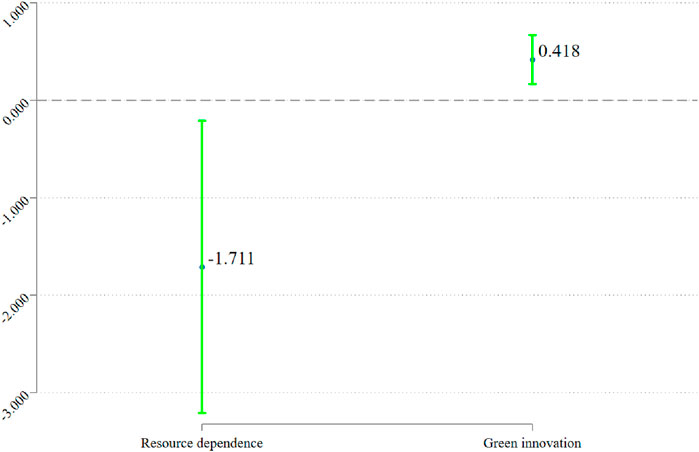
Figure 6. The results of mechanism analysis. Note: Standard errors are corrected for heteroskedasticity. Error bars indicate 90% confidence intervals. The same below.
4.5.2 Improving green innovation capacity
This section uses the size of green patent to represent a city’s green innovation level (Wu et al., 2023). We treat green innovation as the dependent variable, with the results shown in Figure 6 (right). At the 5% significance level, the PCRC significantly enhances urban green innovation capacity. This finding indicates that the program improves ecological resilience by fostering green innovation. Therefore, increasing green innovation capacity is one of the channels through which the program influences ecological resilience, confirming Hypothesis 3.
4.6 Heterogeneity analysis
4.6.1 Classification according to resource base
We classify the sample into two groups: resource-based cities and other cities.6 The empirical results, presented in Figure 7a, clearly show that for resource-based cities, the PCRC significantly enhances ecological resilience (coefficient = 0.039, t = 3.727). For other cities, the impact of the PCRC is not statistically significant (coefficient = 0.006, t = 0.700).
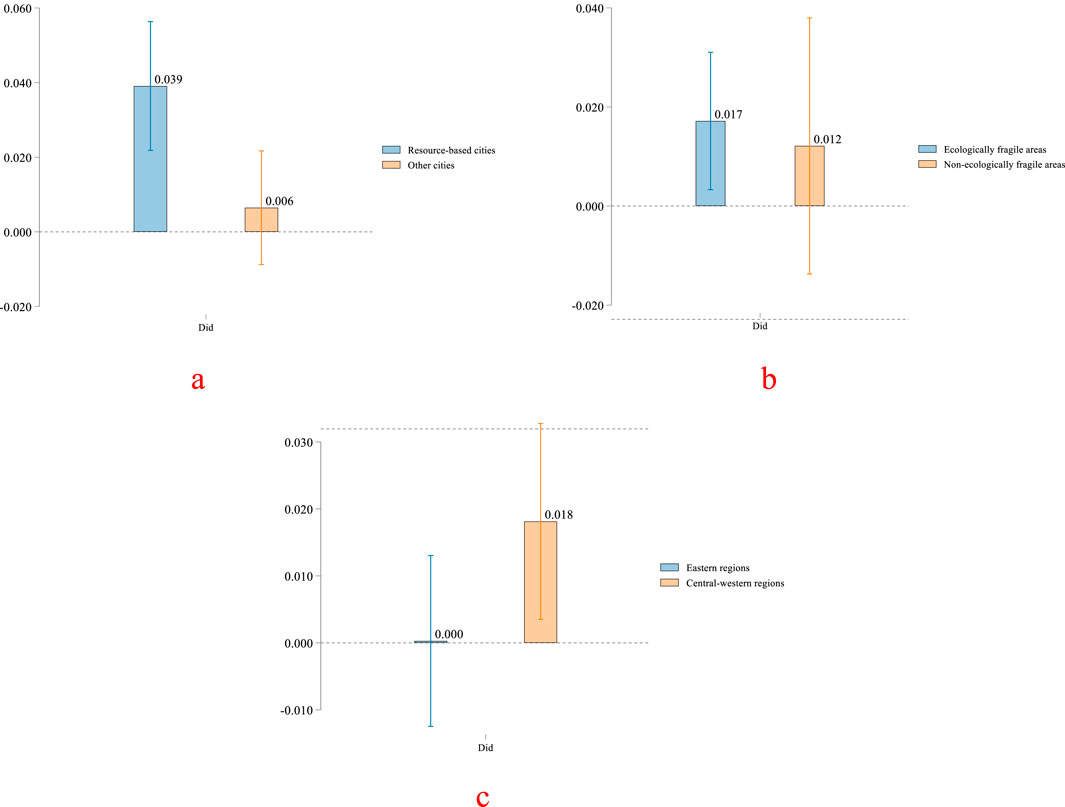
Figure 7. The results of heterogeneity analysis. (a) Classification according to resource base. (b) Ecologically fragile and non-ecologically fragile areas (c) Locational heterogeneity.
The differences in economic structure, resource dependence, and environmental pressure between resource-based and other cities help explain these findings. Resource-based cities are typically highly reliant on the extraction and utilization of natural resources, rendering them more vulnerable to resource depletion and environmental degradation. Consequently, the PCRC plays a vital role in these cities by encouraging the adoption of more sustainable development models and environmental management practices. This shift enables resource-based cities to move away from traditional, resource-dependent growth paths, significantly enhancing their ecological resilience (Li et al., 2024). However, other cities generally possess more diversified economies and lower degrees of resource dependence. As a result, their ecological conditions tend to be more stable, with a stronger foundation of resilience. Thus, the marginal effect of the PCRC in these cities may be limited. As the empirical results suggest, the program did not yield significant improvements in the ecological resilience of other cities.
4.6.2 Ecologically fragile and non-ecologically fragile areas
Following the National Ecologically Fragile Zone Protection Plan,7 we categorize the sample into ecologically fragile zones and non-fragile zones. The ecologically fragile zones encompass 21 provincial units. The empirical results are presented in Figure 7b, with the left and right columns representing ecologically fragile and non-fragile zones, respectively. For the ecologically fragile zones, the PCRC significantly enhances the ecological resilience of pilot cities (coefficient = 0.017, t = 2.036). In contrast, for non-fragile cities, the impact of the PCRC on ecological resilience is not statistically significant (coefficient = 0.012, t = 0.772).
Ecologically fragile zones typically face more severe environmental pressures, such as land degradation, water scarcity, and biodiversity loss. Given the inherent vulnerability of these ecosystems, they are more susceptible to damage when confronted with climate change or other external shocks. As a result, fragile zones have a more urgent need for policy intervention to strengthen their ecological resilience. The PCRC addresses these needs by promoting sustainable urban development, enhancing ecological restoration, and improving environmental management, thereby significantly bolstering the resilience of these vulnerable regions. This explains the significant and positive impact of the PCRC in ecologically fragile zones. In contrast, non-fragile zones tend to possess more robust ecosystems and greater environmental carrying capacities, making them more resilient to climate change and other environmental challenges. These regions likely already exhibit a strong baseline of ecological resilience, which may account for the diminished marginal effects of the PCRC in these areas. As the empirical results suggest, the policy’s impact on ecological resilience in non-fragile zones is not statistically significant, reflecting the relatively smaller room for improvement in these already resilient areas.
4.6.3 Locational heterogeneity
Following Tian et al. (2023), we examine the regional heterogeneity in the effects of the PCRC. The empirical results are presented in Figure 7c, with the left and right columns representing the eastern and central-western regions, respectively. For the eastern provinces and cities, the PCRC shows no significant influence on the ecological resilience of pilot cities (coefficient = 0.000, t = 0.040). In contrast, for the central-western regions, the program significantly enhances the ecological resilience of pilot cities (coefficient = 0.018, t = 2.040).
Eastern regions have long been the most economically developed area, characterized by higher levels of urbanization and a more established environmental governance framework. As these areas already possess a solid foundation of ecological resilience, the marginal impact of the PCRC may be relatively small. The central and western regions, with slower urbanization, face more pronounced challenges in environmental governance and infrastructure development. Given the weaker base of ecological resilience in these areas, they are more vulnerable to environmental pressures and the effects of climate change. Simultaneously, the PCRC plays a pivotal role in advancing local ecological governance and bolstering urban capacity to address environmental challenges.
5 Conclusion, insights and limitations
This study provides a comprehensive evaluation of the causal effect of China’s PCRC initiative on urban ecological resilience. The key findings are summarized as follows. First, the PCRC significantly enhance ecological resilience in pilot cities, the conclusion robustly supports through a series of robustness checks. Second, mechanism analysis reveals that reducing resource dependence and enhancing green innovation capacity are two crucial pathways through which the PCRC improves ecological resilience. Third, the PCRC significantly improves resource-based cities’ ecological resilience, while its impact on other cities is not statistically significant. Fourth, compared to non-ecologically vulnerable areas, the PCRC significantly enhances ecological resilience in ecologically vulnerable areas. Finally, the PCRC has markedly improved ecological resilience in the central and western regions, whereas no significant effect is observed in the eastern regions. Our research provides empirical evidence to enhance urban ecological resilience.
We offer the following policy implications for reference:
First, the PCRC significantly enhances ecological resilience in pilot cities, demonstrating the program’s effectiveness. Consequently, the government should consider expanding the scope of the pilot program to include a greater number of cities. During this expansion, it is crucial to account for the regional characteristics and development levels of different cities, tailoring climate adaptation policies to local contexts. Additionally, the government should strengthen long-term monitoring and evaluation of pilot cities to ensure the sustainability and effectiveness of the policy. This approach will not only help optimize policy implementation, but also provide a scientific basis for future policy adjustments and improvements. Furthermore, to enhance ecological resilience in pilot cities, increased investment in infrastructure is essential. Particularly in areas related to managing extreme climate events and environmental risks, thereby bolstering the overall capacity of cities to respond to such challenges.
Second, reducing resource dependence and enhancing green innovation capacity are two pivotal pathways through which the PCRC improves ecological resilience. Accordingly, the government should prioritize the green transformation of pilot cities and further augment their green innovation capabilities. On the one hand, targeted policies and financial incentives should be developed to encourage pilot cities to diminish reliance on traditional resource-intensive industries and facilitate a transition towards a green, low-carbon economic structure. This can be achieved by guiding resource-based industries through technological upgrades and structural adjustments, thereby mitigating excessive dependence on natural resources and alleviating environmental pressures. On the other hand, the government should intensify support for green innovation by encouraging businesses and research institutions to increase their investments in green technology, particularly in areas such as energy conservation, emissions reduction, new energy development, and environmental protection technologies. Establishing dedicated green funds and reward mechanisms can further support businesses in pursuing green technological innovations and foster the widespread adoption of these technologies. Additionally, efforts should be made to promote and disseminate green innovation achievements, encouraging experience sharing and collaboration among cities to enhance the overall green innovation capacity.
Third, the heterogeneity analysis reveals that differentiated strategies should be adopted to address the specific needs and challenges of various types of cities. Resource-based cities, which often rely heavily on resource-intensive industries, face substantial ecological and environmental pressures. To address this, the government could establish a resource-based city fund to support investments in green industries, the introduction of environmental technologies, and infrastructure improvements. Ecologically vulnerable areas, due to their unique geographical and ecological conditions, are more susceptible to the influences of climate change. In response, the government could allocate special funds to support ecological restoration and environmental management projects in these regions, with a focus on combating land degradation, soil erosion, and preserving biodiversity. The central and western regions face greater challenges in adapting to climate change and enhancing ecological resilience. To address these challenges, the government could increase infrastructure investment in these regions, particularly in environmental facilities, green energy, and public services, to strengthen their ecological resilience. Meanwhile, the government should encourage the central and western regions to explore and promote locally suitable green development models, fostering a transition toward sustainable economic growth.
However, our study has certain limitations. First, given some practical limitations, this paper does not explore other avenues for the PCRC. For example, the PCRC may improve ecological resilience by influencing sustainable and renewable energy development. Therefore, future research could explore additional channels through which the PCRC influence ecological resilience. Second, as a multifaceted concept, ER encompasses diverse dimensions such as the capacity of urban systems to absorb shocks, recover from disturbances, and adapt to long-term environmental changes. While we adopted a widely recognized framework to define and measure ER, alternative frameworks might emphasize different aspects, such as social equity, cultural resilience, or specific ecosystem services. The use of a different definition or measurement approach could potentially influence the outcomes of the analysis. Finally, subsequent study could use spatial econometric methods to analyze the spatial effects of the program. For example, the spatial DID model could offer valuable insights into the spatial dynamics of the PCRC (Wang and Salman, 2025), enhancing our understanding of its broader regional impacts.
Data availability statement
The raw data supporting the conclusions of this article will be made available by the authors, without undue reservation.
Author contributions
TZ: Data curation, Investigation, Methodology, Writing–original draft, Writing–review and editing. CW: Data curation, Investigation, Methodology, Writing–original draft, Writing–review and editing, Supervision. DD: Data curation, Investigation, Writing–original draft, Software.
Funding
The author(s) declare that no financial support was received for the research, authorship, and/or publication of this article.
Conflict of interest
The authors declare that the research was conducted in the absence of any commercial or financial relationships that could be construed as a potential conflict of interest.
Generative AI statement
The author(s) declare that no Generative AI was used in the creation of this manuscript.
Publisher’s note
All claims expressed in this article are solely those of the authors and do not necessarily represent those of their affiliated organizations, or those of the publisher, the editors and the reviewers. Any product that may be evaluated in this article, or claim that may be made by its manufacturer, is not guaranteed or endorsed by the publisher.
Footnotes
1Source: https://wmo.int/publication-series/state-of-global-climate-2023
2Information derived from: https://www.fmprc.gov.cn/web/ziliao_674904/zt_674979/dnzt_674981/qtzt/2030kcxfzyc_686343/zw/201601/t20160113_9279987.shtml
3The official source of the document is: https://www.gov.cn/xinwen/2017-02/25/content_5170863.htm#1
4Source: https://www.gov.cn/gzdt/2007-06/04/content_635590.htm
5This paper discusses the impact of the PCRC on mediating variables to identify potential mechanisms. Referring to the robustness test approach of the benchmark regression, we conducted a robustness test for the mediation effect. The mediation effect still holds after we consider the interaction fixed effects model, change the sample, include other environmental policies, and change the algorithm. Thus, we can identify that the PCRC can increase ecological resilience by reducing resource dependence and improving green innovation.
6Basis for grouping: https://www.gov.cn/zwgk/2013-12/03/content_2540070.htm
7The grouping criteria are derived from: https://www.gov.cn/gongbao/content/2009/content_1250928.htm
References
Amirzadeh, M., Sobhaninia, S., Buckman, S. T., and Sharifi, A. (2023). Towards building resilient cities to pandemics: a review of COVID-19 literature. Sustain. Cities Soc. 89, 104326. doi:10.1016/j.scs.2022.104326
Banai, R. (2020). Pandemic and the planning of resilient cities and regions. Cities 106, 102929. doi:10.1016/j.cities.2020.102929
Baron, E. J. (2022). School spending and student outcomes: evidence from revenue limit elections in Wisconsin. Am. Econ. Journal-Economic Policy 14 (1), 1–39. doi:10.1257/pol.20200226
Bodory, H., Huber, M., and Lafférs, L. (2022). Evaluating (weighted) dynamic treatment effects by double machine learning. Econ. J. 25 (3), 628–648. doi:10.1093/ectj/utac018
Cai, Y., Loi, E. H., Tung, C.-L., Wang, H., and Zheng, J. (2025). Clean energy development and low-carbon transition in China’s power industry. Front. Environ. Sci. 12, 1525047. doi:10.3389/fenvs.2024.1525047
Champlin, C., Sirenko, M., and Comes, T. (2023). Measuring social resilience in cities: an exploratory spatio-temporal analysis of activity routines in urban spaces during Covid-19. Cities 135, 104220. doi:10.1016/j.cities.2023.104220
Chen, S., and Gong, B. L. (2021). Response and adaptation of agriculture to climate change: evidence from China. J. Dev. Econ. 148, 102557. doi:10.1016/j.jdeveco.2020.102557
Chen, X., Chen, X., Xu, L. H., and Wen, F. H. (2023). Attention to climate change and downside risk: evidence from China. Risk Anal. 43 (5), 1011–1031. doi:10.1111/risa.13975
Chen, Z., Kahn, M. E., Liu, Y., and Wang, Z. (2018). The consequences of spatially differentiated water pollution regulation in China. J. Environ. Econ. Manag. 88, 468–485. doi:10.1016/j.jeem.2018.01.010
Chernozhukov, V., Chetverikov, D., Demirer, M., Duflo, E., Hansen, C., and Newey, W. (2017). Double/debiased/neyman machine learning of treatment effects. Am. Econ. Rev. 107 (5), 261–265. doi:10.1257/aer.p20171038
Cui, Y., Yin, M. Q., Cheng, X., Tang, J. Q., and He, B. J. (2024). Towards cool cities and communities: preparing for an increasingly hot future by the development of heat-resilient infrastructure and urban heat management plan. Environ. Technol. and Innovation 34, 103568. doi:10.1016/j.eti.2024.103568
Dong, Z. Y. Z., Shen, H. J., Zhang, W. W., Wu, R., and Wang, S. J. (2022). How does resource dependence relate cities' technology diversification? The role of density and complexity. Cities 130, 103883. doi:10.1016/j.cities.2022.103883
Feng, X. H., Zeng, F. S., Loo, B. P. Y., and Zhong, Y. X. (2024). The evolution of urban ecological resilience: an evaluation framework based on vulnerability, sensitivity and self-organization. Sustain. Cities Soc. 116, 105933. doi:10.1016/j.scs.2024.105933
Feng, Y., Lee, C. C., and Peng, D. Y. (2023). Does regional integration improve economic resilience? Evidence from urban agglomerations in China. Sustain. Cities Soc. 88, 104273. doi:10.1016/j.scs.2022.104273
Filiou, D., Kesidou, E., and Wu, L. C. (2023). Are smart cities green? The role of environmental and digital policies for Eco-innovation in China. World Dev. 165, 106212. doi:10.1016/j.worlddev.2023.106212
Gao, Y. Q., Xu, M. Q., Zheng, H., Liu, Y. P., and Xu, J. (2024). Modeling and application of urban waterlogging resilience assessment based on PSR-NES framework and analysis of driving mechanisms. Water Sci. Technol. 90 (5), 1589–1614. doi:10.2166/wst.2024.295
Gao, Z., Cai, L., and Zhang, X. (2024). New industrial land use policy and firms’ green technology innovation in China-an empirical study based on double machine learning model. Front. Environ. Sci. 12, 1356291. doi:10.3389/fenvs.2024.1356291
Haarstad, H., Grandin, J., and Solberg, R. R. (2024). Do cities have tools to meet their climate targets? The limits of soft governance in climate action plans. Cities 151, 105142. doi:10.1016/j.cities.2024.105142
Hansen, J. H., and Siggaard, M. V. (2024). Double machine learning: explaining the post-earnings announcement drift. J. Financial Quantitative Analysis 59 (3), 1003–1030. doi:10.1017/s0022109023000133
Hong, H., Li, F. W., and Xu, J. M. (2019). Climate risks and market efficiency. J. Econ. 208 (1), 265–281. doi:10.1016/j.jeconom.2018.09.015
Hu, H., Yan, K. G., Shi, Y., Lv, T. G., Zhang, X. M., and Wang, X. Y. (2024). Decrypting resilience: the spatiotemporal evolution and driving factors of ecological resilience in the Yangtze River Delta Urban Agglomeration. Environ. Impact Assess. Rev. 106, 107540. doi:10.1016/j.eiar.2024.107540
Hu, X. H., Li, L. G., and Dong, K. (2022). What matters for regional economic resilience amid COVID-19? Evidence from cities in Northeast China. Cities 120, 103440. doi:10.1016/j.cities.2021.103440
Huang, J., Zhong, P. S., Zhang, J. Z., and Zhang, L. (2023). Spatial-temporal differentiation and driving factors of ecological resilience in the Yellow River Basin, China. Ecol. Indic. 154, 110763. doi:10.1016/j.ecolind.2023.110763
Huang, Q. Q., and Yi, C. Z. (2024). How does the construction of climate adaptive cities enhance climate resilience? J. Environ. Plan. Manag., 1–23. doi:10.1080/09640568.2024.2362920
IPCC (2023). AR6 synthesis report: climate change 2023. Available at: https://www.ipcc.ch/report/sixth-assessment-report-cycle/.
Iturriza, M., Labaka, L., Hernantes, J., and Abdelgawad, A. (2020). Shifting to climate change aware cities to facilitate the city resilience implementation. Cities 101, 102688. doi:10.1016/j.cities.2020.102688
Jiang, N. N., and Jiang, W. (2024). How does regional integration policy affect urban resilience? Evidence from urban agglomeration in China. Environ. Impact Assess. Rev. 104, 107298. doi:10.1016/j.eiar.2023.107298
Jiang, W., and Jiang, N. N. (2024). From sustainable development towards resilience: does digital finance matter in enhancing ecological resilience? Sustain. Dev. doi:10.1002/sd.3257
Jiang, W., Wang, K. L., and Miao, Z. (2024). How does internet development affect urban eco-resilience: evidence from China. Econ. Change Restruct. 57 (2), 49. doi:10.1007/s10644-024-09632-x
Jiao, L. D., Wang, L., Lu, H., Fan, Y. W., Zhang, Y., and Wu, Y. (2023). An assessment model for urban resilience based on the pressure-state-response framework and BP-GA neural network. Urban Clim. 49, 101543. doi:10.1016/j.uclim.2023.101543
Knaus, M. C. (2022). Double machine learning-based programme evaluation under unconfoundedness. Econ. J. 25 (3), 602–627. doi:10.1093/ectj/utac015
Lee, C. C., Zeng, M. L., and Luo, K. (2024). How does climate change affect food security? Evidence from China. Environ. Impact Assess. Rev. 104, 107324. doi:10.1016/j.eiar.2023.107324
Li, G. Z., and Wang, L. Q. (2023). Study of regional variations and convergence in ecological resilience of Chinese cities. Ecol. Indic. 154, 110667. doi:10.1016/j.ecolind.2023.110667
Li, W., Wang, C., Duan, D., Li, Q., Tian, R., and Ma, T. (2024). Unlocking the nexus: exploring the effect of urban green innovation on haze pollution and carbon emissions intensity in Chinese cities. Front. Environ. Sci. 12, 1440976. doi:10.3389/fenvs.2024.1440976
Liao, L. (2024). Synergy of soft and hard regulations in climate governance: the impact of state policies on local climate mitigation actions. Environ. Policy Gov. doi:10.1002/eet.2145
Liao, Z. J., and Zhang, L. J. (2024). Analyzing and predicting the urbanization and ecological resilience coupling and coordination of Guangdong Province. Humanit. and Soc. Sci. Commun. 11 (1), 1322–1414. doi:10.1057/s41599-024-03851-3
Ling, S., Jin, S. R., Wang, H. J., Zhang, Z. H., and Feng, Y. C. (2024). Transportation infrastructure upgrading and green development efficiency: empirical analysis with double machine learning method. J. Environ. Manag. 358, 120922. doi:10.1016/j.jenvman.2024.120922
Liu, L., Mukherjee, R., and Robins, J. M. (2024). Assumption-lean falsification tests of rate double-robustness of double-machine-learning estimators. J. Econ., 240(2), 105500. doi:10.1016/j.jeconom.2023.105500
Liu, L. N., Lei, Y. L., Fath, B. D., Hubacek, K., Yao, H. J., and Liu, W. (2022). The spatio-temporal dynamics of urban resilience in China?s capital cities. J. Clean. Prod. 379, 134400. doi:10.1016/j.jclepro.2022.134400
Liu, M. L., Zhang, Y., and Zhou, D. D. (2021). Double/debiased machine learning for logistic partially linear model. Econ. J. 24 (3), 559–588. doi:10.1093/ectj/utab019
Liu, Z. Y., Lam, J. F. I., Chen, H. X., Lin, G. C., and Chen, H. X. (2023). Can green investment improve China's regional energy consumption structure? novel findings and implications from sustainable energy systems perspective. Front. Energy Res. 11, 1273347. doi:10.3389/fenrg.2023.1273347
Ning, X., Zhao, J. M., and An, Y. (2024). Urbanization and urban ecological resilience in resource-based cities: coupling coordination and its key factors. Environ. Dev. Sustain., 1–24. doi:10.1007/s10668-024-05609-y
Qi, J. J., and Dauvergne, P. (2022). China's rising influence on climate governance: forging a path for the global South. Glob. Environ. Change-Human Policy Dimensions 73, 102484. doi:10.1016/j.gloenvcha.2022.102484
Shamsipour, A., Jahanshahi, S., Mousavi, S. S., Shoja, F., Golenji, R. A., Tayebi, S., et al. (2024). Assessing and mapping urban ecological resilience using the loss-gain approach: a case study of Tehran, Iran. Sustain. Cities Soc. 103, 105252. doi:10.1016/j.scs.2024.105252
Shi, J. P., and Fan, H. Y. (2024). Regulatory mechanisms for climate-resilient urban energy systems. Sustain. Cities Soc. 102, 105215. doi:10.1016/j.scs.2024.105215
Sun, Y. P., Jia, R. Y., Razzaq, A., and Bao, Q. (2024). Social network platforms and climate change in China: evidence from TikTok. Technol. Forecast. Soc. Change 200, 123197. doi:10.1016/j.techfore.2023.123197
Tang, P., Liu, X., Mi, L., Wang, G., and Wang, J. (2024). Dual-threshold effect of resources and governance on the role of regulations in green innovation: novel insights from a four-regime panel approach. Bus. Strategy Environ. 34, 2667–2679. doi:10.1002/bse.4040
Tang, P. C., Wang, C., Jiang, Q. S., Liu, X., and Wang, J. Y. (2023). Symbol or substance? Environmental regulations and corporate environmental actions decoupling. J. Environ. Manag. 346, 118950. doi:10.1016/j.jenvman.2023.118950
Tian, M. J., Hong, M. Y., and Wang, J. (2023). Land resources, market-oriented reform and high-quality agricultural development. Econ. Change Restruct. 56 (6), 4165–4197. doi:10.1007/s10644-023-09569-7
Wang, D., and Chen, S. W. (2024). The effect of pilot climate-resilient city policies on urban climate resilience: evidence from quasi-natural experiments. Cities 153, 105316. doi:10.1016/j.cities.2024.105316
Wang, D. M., Yang, W. J., Geng, X. C., and Li, Q. (2024a). Information disclosure, multifaceted collaborative governance, and carbon total factor productivity-an evaluation of the effects of the 'environmental information disclosure pilot' policy based on double machine learning. J. Environ. Manag. 366, 121817. doi:10.1016/j.jenvman.2024.121817
Wang, G., and Salman, M. (2025). Spatial effect decomposition of new-type urbanization on green development efficiency in China: based on an improved spatial DID model. Environ. Dev. Sustain., 1–25. doi:10.1007/s10668-025-05974-2
Wang, H. P., and Ge, Q. (2024). Ecological resilience of three major urban agglomerations in China from the “environment-society” coupling perspective. Ecol. Indic. 169, 112944. doi:10.1016/j.ecolind.2024.112944
Wang, J., Wang, J. M., and Zhang, J. N. (2023a). Spatial distribution characteristics of natural ecological resilience in China. J. Environ. Manag. 342, 118133. doi:10.1016/j.jenvman.2023.118133
Wang, K. W., Ma, H. T., and Fang, C. L. (2023b). The relationship evolution between urbanization and urban ecological resilience in the Northern Slope Economic Belt of Tianshan Mountains, China. Sustain. Cities Soc. 97, 104783. doi:10.1016/j.scs.2023.104783
Wang, L., Yuan, M. K., Li, H. L., and Chen, X. D. (2023c). Exploring the coupling coordination of urban ecological resilience and new-type urbanization: the case of China's Chengdu-Chongqing Economic Circle. Environ. Technol. and Innovation 32, 103372. doi:10.1016/j.eti.2023.103372
Wang, S., Cui, Z., Lin, J., Xie, J., and Su, K. (2022). The coupling relationship between urbanization and ecological resilience in the Pearl River Delta. J. Geogr. Sci. 32 (1), 44–64. doi:10.1007/s11442-022-1935-3
Wang, S. B., Li, Z. Y., Long, Y., Yang, L., Ding, X. Y., Sun, X. L., et al. (2024b). Impacts of urbanization on the spatiotemporal evolution of ecological resilience in the plateau lake area in central yunnan, China. Ecol. Indic. 160, 111836. doi:10.1016/j.ecolind.2024.111836
Wen, H. W., Hu, K. Y., Nghiem, X. H., and Acheampong, A. O. (2024). Urban climate adaptability and green total-factor productivity: evidence from double dual machine learning and differences-in-differences techniques. J. Environ. Manag. 350, 119588. doi:10.1016/j.jenvman.2023.119588
Wu, J. X., Nie, X., Wang, H., and Li, W. J. (2023). Eco-industrial parks and green technological progress: evidence from Chinese cities. Technol. Forecast. Soc. Change 189, 122360. doi:10.1016/j.techfore.2023.122360
Wu, W. T., Gao, Y. W., and Chen, C. P. (2024). CLSER: a new indicator for the social-ecological resilience of coastal systems and sustainable management. J. Clean. Prod. 435, 140564. doi:10.1016/j.jclepro.2024.140564
Xu, J. Y., and Zhang, Y. (2022). Has the international climate regime promoted climate justice? Evidence from Clean Development Mechanism projects in China. Clim. Policy 22 (2), 222–235. doi:10.1080/14693062.2021.2008294
Yan, J. L. (2024). Climate governance and industrial ecological transformation. Corp. Soc. Responsib. Environ. Manag. 32, 718–728. doi:10.1002/csr.2987
Yuan, Y., Zheng, Y., Huang, X. K., and Zhai, J. Q. (2024). Climate resilience of urban water systems: a case study of sponge cities in China. J. Clean. Prod. 451, 141781. doi:10.1016/j.jclepro.2024.141781
Zahoor, A., Xu, T., Wang, M., Dawood, M., Afrane, S., Li, Y., et al. (2023). Natural and artificial green infrastructure (GI) for sustainable resilient cities: a scientometric analysis. Environ. Impact Assess. Rev. 101, 107139. doi:10.1016/j.eiar.2023.107139
Zhang, J. N., Fan, J. H., and Ma, Y. F. (2024). Does artificial intelligence promote provincial ecological resilience? Evidence from China. Appl. Econ. Lett. 31 (16), 1590–1597. doi:10.1080/13504851.2024.2384532
Zhang, T., Sun, Y. X., Zhang, X. B., Yin, L., and Zhang, B. L. (2023). Potential heterogeneity of urban ecological resilience and urbanization in multiple urban agglomerations from a landscape perspective. J. Environ. Manag. 342, 118129. doi:10.1016/j.jenvman.2023.118129
Zhao, R. D., Fang, C. L., Liu, J., and Zhang, L. F. (2022). The evaluation and obstacle analysis of urban resilience from the multidimensional perspective in Chinese cities. Sustain. Cities Soc. 86, 104160. doi:10.1016/j.scs.2022.104160
Zhao, X., Ke, X., Jiang, S., and You, X. (2024). Exploring the dynamics of urban energy efficiency in China: a double machine learning analysis of green finance influence. Environ. Technol. and Innovation 35, 103653. doi:10.1016/j.eti.2024.103653
Zheng, J. S., Chen, Z. Y., Zhang, T., Huang, X. Q., and Wang, X. (2023). Regional sustainable and renewable energy development in China: a comprehensive assessment and influencing factors. Energy Rep. 9, 76–80. doi:10.1016/j.egyr.2023.09.119
Zheng, K. Y., Tan, L. S., Sun, Y. W., Wu, Y. J., Duan, Z., Xu, Y., et al. (2021). Impacts of climate change and anthropogenic activities on vegetation change: evidence from typical areas in China. Ecol. Indic. 126, 107648. doi:10.1016/j.ecolind.2021.107648
Zhou, Q., Zhu, M. K., Qiao, Y. R., Zhang, X. L., and Chen, J. (2021). Achieving resilience through smart cities? Evidence from China. Habitat Int. 111, 102348. doi:10.1016/j.habitatint.2021.102348
Zhou, X., Wang, H., Duan, Z. X., and Zhou, G. Q. (2024). Exploring the impacts of urbanization on ecological resilience from a spatiotemporal heterogeneity perspective: evidence from 254 cities in China. Environ. Dev. Sustain., 1–20. doi:10.1007/s10668-024-05770-4
Zhou, Y. Q., Wu, S., Liu, Z. H., and Rognone, L. (2023). The asymmetric effects of climate risk on higher-moment connectedness among carbon, energy and metals markets. Nat. Commun. 14 (1), 7157. doi:10.1038/s41467-023-42925-9
Keywords: climate governance, ecological resilience, double machine learning method, resource dependence, green innovation
Citation: Zhang T, Wang C and Duan D (2025) Pilot climate resilient cities and ecological resilience: evidence from double machine learning method. Front. Environ. Sci. 13:1530104. doi: 10.3389/fenvs.2025.1530104
Received: 18 November 2024; Accepted: 12 February 2025;
Published: 17 June 2025.
Edited by:
Carmine Massarelli, National Research Council of Italy - Construction Technologies Institute, ItalyReviewed by:
Ruopu Li, Southern Illinois University Carbondale, United StatesJiansong Zheng, Macao Polytechnic University, China
Copyright © 2025 Zhang, Wang and Duan. This is an open-access article distributed under the terms of the Creative Commons Attribution License (CC BY). The use, distribution or reproduction in other forums is permitted, provided the original author(s) and the copyright owner(s) are credited and that the original publication in this journal is cited, in accordance with accepted academic practice. No use, distribution or reproduction is permitted which does not comply with these terms.
*Correspondence: Chao Wang, MTg3OTAxMDg4MzlAMTYzLmNvbQ==
 Tian Zhang
Tian Zhang Chao Wang
Chao Wang Dingkang Duan1,2
Dingkang Duan1,2